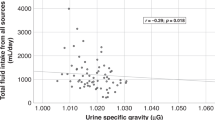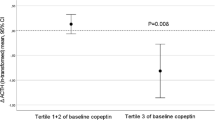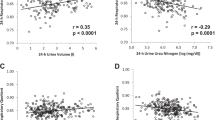Abstract
Background/objectives:
Urinary and plasma indices are utilized to assess whole-body water balance in healthy adults, whereas the urine-to-plasma osmolality ratio (Uosm:Posm) rarely is. To explore the efficacy of Uosm:Posm as a hydration biomarker, diet records of 120 college women were analyzed (beverage water+food water=total fluid intake (TFI); 5 days) to identify habitual high-volume (HIGH) and low-volume (LOW) drinkers.
Subjects/methods:
The experimental protocol first involved two ad libitum baseline days for HIGH (TFI, 3.21 l per 24 h; n=14) and LOW (TFI, 1.64 l per 24 h; n=14). During a controlled intervention (days 3–6), mineral water was the only beverage; HIGH consumed less than baseline (TFI, 2.00 l per 24 h), and LOW consumed more than baseline (TFI, 3.50 l per 24 h). During ad libitum recovery (day 7), TFI were 3.17 and 1.71 l per 24 h for HIGH and LOW, respectively. Duplicate Uosm (24 h collection) and Posm (morning) samples were analyzed on all days via freezing point depression osmometry.
Results:
In the evaluation of relative water excess (Uosm:Posm<1.0), 11/13 values occurred for HIGH on days 1, 2 and 7; for LOW, 28/29 occurred on intervention days 3–6. Chi-squared analysis indicated that the treatment and Uosm:Posm were significantly associated (χ21:0.001=23.5, P<0.001). Statistical regression analyses detected a strong, significant relationship between renal free-water clearance (FWC) and Uosm:Posm (r2=0.86, P<0.00001); this was not true for FWC and Posm (r2=0.00, P=0.40) because Posm values were stable across 7 days.
Conclusions:
These findings support the use of Uosm:Posm as a hydration biomarker.
This is a preview of subscription content, access via your institution
Access options
Subscribe to this journal
Receive 12 print issues and online access
$259.00 per year
only $21.58 per issue
Buy this article
- Purchase on Springer Link
- Instant access to full article PDF
Prices may be subject to local taxes which are calculated during checkout


Similar content being viewed by others
References
Armstrong LE . Assessing hydration status: the elusive gold standard. J Am Coll Nutr 2007; 26 (5 Suppl), 575S–584S.
McKiernan F, Hollis JH, McCabe GP, Mattes RD . Thirst-drinking, hunger-eating; Tight coupling? J Am Diet Assoc 2009; 109: 486–490.
Vokes T . Water homeostasis. Ann Rev Nutr 1987; 7: 383–406.
Cheuvront SN, Ely BR, Kenefick RW, Sawka MN . Biological variation and diagnostic accuracy of dehydration assessment markers. Am J Clin Nutr 2010; 92: 565–573.
Shirreffs SM . Markers of hydration status. J Sports Med Phys Fitness 2000; 40: 80–84.
Kavouras S . Assessing hydration status. Cur Opin Clin Nutr Metab Care 2002; 5: 519–524.
Lins RL, Verpooten GA, De Clerck DS, De Broe ME . Urinary indices in acute interstitial nephritis. Clin Nephrol 1986; 26: 131–133.
Moses AM, Miller M . Urine and plasma osmolality in diagnosis and management of dilutional hyponatremia. Postgrad Med 1972; 52: 232–235.
Strasinger SK, Di Lorenzo MS . Urinalysis and Body Fluids. F.A. Davis Co.: Philadelphia, PA, USA, 2008.
Armstrong LE, Johnson EC, Munoz CX, Swokla B, Le Bellego L, Jimenez L et al. Hydration biomarkers and dietary fluid consumption of women. J Acad Nutr Diet 2012; 112: 1056–1061.
Ganong WF . Regulation of extracellular fluid composition and volume. Review of Medical Physiology 19th edn Appleton & Lange Co.: Stamford, CT, USA, 1999.
Guyton AC, Hall JE . Regulation of extracellular fluid osmolarity and sodium concentration. In: Textbook of Medical Physiology 9th edn W.B. Saunders Co.: Philadelphia, PA, USA, 1996.
Armstrong LE, Pumerantz AC, Fiala KA, Roti MW, Kavouras SA, Casa DJ et al. Human hydration indices: acute and longitudinal reference values. Int J Sport Nutr Exerc Metab 2010; 20: 145–153.
Decision Support Systems, LP, Fort Worth, TX, USA. http://www.dssresearch.com/toolkit/sscalc/size_a2.asp (accessed 2012.
Perucca J, Bouby N, Valeix P, Bankir L . Sex difference in urine concentration across differing ages, sodium intake, and level of kidney disease. Am J Physiology Renal Physiol 2007; 292: R700–R705.
Jacobson MH, Levy SE, Kaufman RM, Gallinek WE, Donnelly OW . Urine osmolality. A definitive test of renal function. Arch Intern Med 1962; 110: 83–89.
Haraway AW, Becker EL . Clinical application of cryoscopy. JAMA 1968; 205: 506–512.
Acknowledgements
This work was funded by Danone Research, France.
Author information
Authors and Affiliations
Corresponding author
Ethics declarations
Competing interests
Professor Armstrong has received compensation as a consultant to ILSI NA and to Danone Research, Palaiseau France; he serves as a Scientific Advisory Board and Expert Working Group member for the Hydration for Health Initiative of Danone Research. Laurent Le Bellego, PhD and Alexis Klein, PhD are employed as researchers, by the grant sponsor Danone Research. Evan C Johnson, Amy L McKenzie, Colleen X Muñoz, Douglas Casa and Carl Maresh declare no conflict of interest.
Rights and permissions
About this article
Cite this article
Armstrong, L., Johnson, E., Munoz, C. et al. Evaluation of Uosm:Posm ratio as a hydration biomarker in free-living, healthy young women. Eur J Clin Nutr 67, 934–938 (2013). https://doi.org/10.1038/ejcn.2013.79
Received:
Accepted:
Published:
Issue Date:
DOI: https://doi.org/10.1038/ejcn.2013.79
Keywords
This article is cited by
-
Markers of the hydration process during fluid volume modification in women with habitual high or low daily fluid intakes
European Journal of Applied Physiology (2015)



